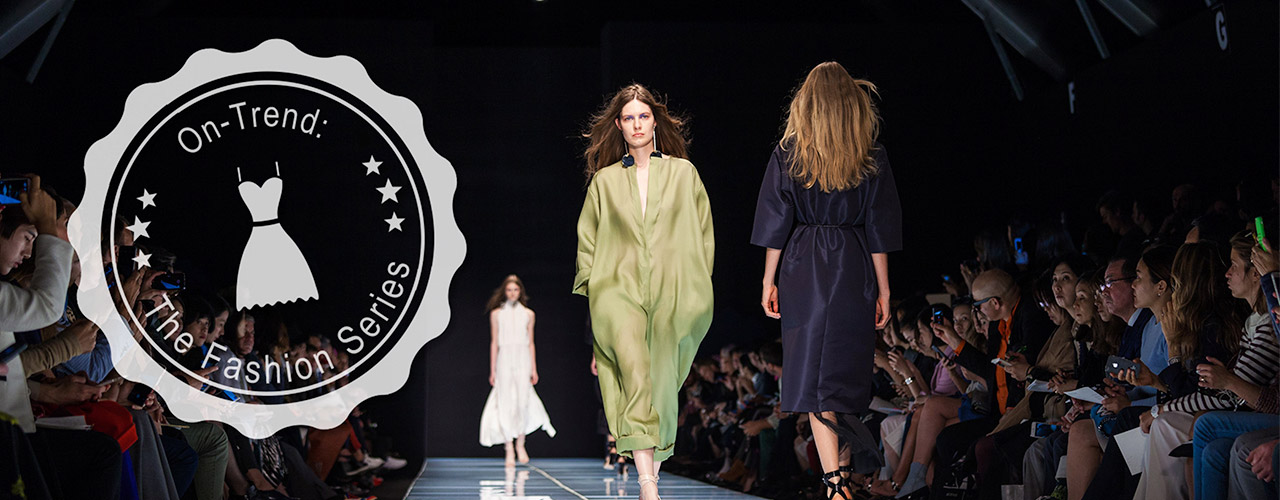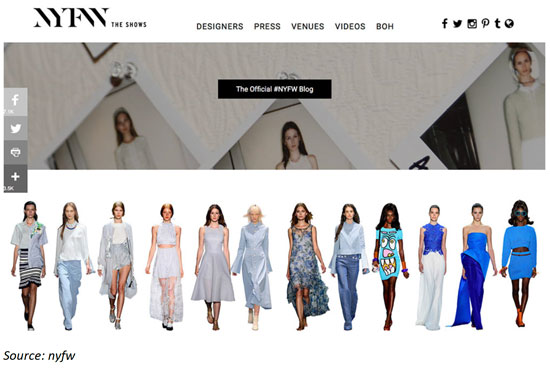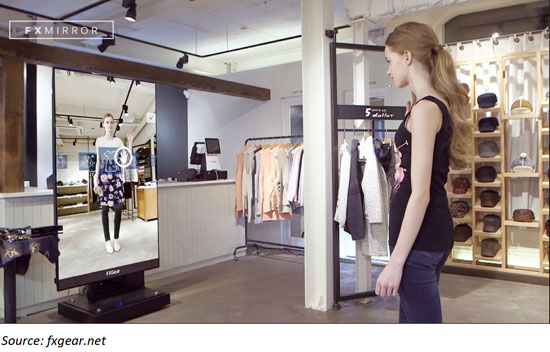
From Runway to Checkout: The See-Now-Buy-Now Trend in Fashion

KEY POINTS
- Impacted by rising digitization, the fashion industry is currently in a state of rapid transformation. High-end fashion brands are evolving towards a see-now-buy-now business model, which consists of runway styles being available for purchase immediately after fashion shows instead of the customary six-month wait.
- The changing fashion industry retail schedule has far-reaching implications for design, marketing and supply chains. This see-now-buy-now development presents additional challenges and increases logistical complexity, as realigning orders and delivery schedules with suppliers is required.
- Major brands and designers that have introduced capsule collections and turned their runway shows into see-now-buy-now formats include Rebecca Minkoff, Burberry, Tommy Hilfiger, Ralph Lauren, Coach and Michael Kors, amongst others. To date, the majority of designers that have adopted instant runway fashion models focus on premium and aspirational price points rather than high-end luxury product.
Introduction
In this report, we discuss the trend for instant fashion, which consists of buying straight from the runway, rather than the customary six-month waiting period. We analyze the factors that have emerged to shape this see-now-buy-now trend, as well as ensuing implications for designers and retailers. We touch on the debate between supporters and detractors, and introduce designers and brands that have embraced instant fashion to date. Finally, we shed light on the fashion industry and how the see-now-buy-now movement is likely to evolve in the future.
The see-now-buy-now trend is one of a number of innovative forces impacting apparel retailing, which we are covering across our On-Trend series of reports.
See-Now-Buy-Now Revolution
Impacted by rising digitalization, the fashion industry is currently in a state of rapid transformation. Growth in ecommerce and social-media shopping is forcing high-end fashion brands toward a consumer-facing, see-now-buy-now business model, which consists of runway styles being available for purchase immediately after fashion shows instead of the customary six-month wait.
The Spring/Summer 2017 fashion show season, which took place in September 2016, was the first season to embrace the see-now-buy-now movement. Burberry was the first major brand to announce a see-now-buy-now runway fashion show with products sold directly to consumers after the catwalk show.
The instant-fashion model can be considered largely a positive development for consumers. The changes taking place are enabling the fashion industry to become more democratic, inclusive and accessible, as the boundaries between traditional fashion buyers and everyday retail buyers are eroding.
However, to date, most see-now-buy-now fashion shows took place during New York Fashion Week and included US designers and accessible-luxury price-point brands. Furthermore, most of the see-now-buy-now product was confined to capsule collections and not complete collections. Some instant-fashion shows were also staged during London Fashion Week in September 2016, and it seems the instant-fashion trend is currently more prevalent in the US and UK than in Italy or France—at least for now.
Traditional Fashion Industry Model
The current fashion industry model follows a traditional seasonal fashion retail calendar that consists of designer brands and luxury houses presenting two seasonal collections per year, which are unveiled at two fashion weeks per year in the core cities of Paris, London, Milan and New York. The Spring/Summer season is presented in September and Fall/Winter is presented in February. A select group of fashion journalists, department-store buyers, celebrities and industry insiders are present at the runway shows, and collection items do not appear for sale in stores until the following season, six months later.
For example, besides a few see-now-buy-now fashion shows held in September 2016, most designers were showing Spring/Summer 2017 collections that will be available for sale in the spring months of 2017.
Traditional fashion capitals customarily had a monopoly on fashion weeks and were highly insulated and exclusive. Department-store buyers would see collections on the runway and then order desired styles for their store network. This would allow brands to test demand for their designs with retailers before committing to big production volumes. Historically, lower-priced retailers and high-street chains would also copy luxury brand catwalk styles from the runway.
The fashion industry, especially the luxury goods industry, was typically slow to embrace ecommerce and social media. Some fashion houses, such as Italy’s Salvatore Ferragamo, are only now offering ready-to-wear ranges for purchase online. Previously, Ferragamo offered only accessories and footwear through its ecommerce website. New York and London fashion weeks are considered more innovative and commercial than those in Paris and Milan.

Catalysts for Change
Traditional fashion cycles no longer reflect consumers’ demands for immediate gratification, and industry changes follow growing consumer desire to purchase collection pieces straight from the runway instead of waiting for six months. Consumers lose interest the more time passes between product viewing and delivery. Nowadays, consumers can order and receive meals, movies, transportation and various services at the click of a button, and are increasingly expecting instant consumption from fashion.
Digitization and social media have influenced retailer advertising, and consumers peruse Facebook, Instagram, Snapchat and Twitter, as well as various apps to make instant product purchase decisions.
Globalization is contributing to the irrelevance of seasons, as products are available globally, including through ecommerce. Manufacturing efficiencies and digitization technologies have allowed companies to supply customers with product more rapidly. Multinational companies cater to stores in the Northern and Southern hemispheres, and to travelers, which have simultaneously differing needs.
Weather patterns have become volatile and unpredictable, and seasonal collections are becoming less and less relevant. According to a Verdict Retail survey conducted in the UK in June 2016, 85.6% of apparel consumers prefer purchasing clothes to wear for the current weather, and 51.4% stated that they do not like purchasing apparel before the next season.
Fast-fashion retailer cycles are influencing the higher-end fashion market. Many fast-fashion retailers introduce new product every couple of weeks, and consumers have come to expect similar product newness from most retailers and service providers, even luxury goods. Furthermore, department-store buyers are losing power and influence in the fashion industry, as department stores have been posting lower sales growth than monobrand stores and ecommerce platforms.
Implications for Designers
The changing fashion industry retail schedule has far-reaching implications for design, marketing and supply chains. The see-now-buy-now development presents additional challenges and increases logistical complexity, as realigning orders and delivery schedules with suppliers is required. Instant fashion necessitates tighter production schedules, even for luxury brands that produce smaller batches of products. Moving production and delivery dates is easier for fast-fashion retailers, especially as these do not have to deal with the wholesale channel and buyers, as many designer brands do.
See-now-buy-now is also risky for designer brands in the sense that designers are unsure of collection product demand and run the risk of under- or over-producing pieces. With the instant-fashion model, design houses will not have the opportunity and time to ascertain wholesale and retail buyer demand for their products, as merchandise will have to be ready for sale immediately after the fashion show that introduces their new collections. Fashion houses have to plan the right inventory mix and volumes to avoid unsold goods ending up in discount stores, which erodes brand image.
As previously mentioned, some designers are creating smaller capsule collections to aid with the logistical difficulties.
Criticisms
The instant-fashion phenomenon is not without critics. Creative brands that focus on craftsmanship and detail need adequate time for design and production.
Some fashion pundits believe that the see-now-buy-now movement may lead to designer burnout, as creating in-season capsule collections in addition to traditional seasonal collections only increases the demands on the designer. The end result could be a reduction in creativity and brand dilution.
Furthermore, many emerging brands do not have the financial means to manufacture seasonal collections unless customer demand is certain.
Finally, at a recent WWD Summit, fashion designer Diane von Furstenberg expressed her dislike of the see-now-buy-now trend, proclaiming it “vulgar.”
The Future?
It is very likely that the fashion industry will generally continue to evolve toward a more straight-to-retail model. More brands, even some higher-end luxury brands, will become more open to selling some collection items to consumers directly following fashion shows. More and more brands will present and sell close-to-season or season-less collections. Fashion houses have no choice but to adapt to the consumer demand for instant gratification.
Improvements in shipping, transportation and package-handling will help brands deliver instant fashion. Retailers will increasingly make use of technological innovations such as 3-D virtual fitting rooms to facilitate size fitting, as well as leverage social media tools such as Facebook Messenger’s chatbot to service customers.

However, see-now-buy-now will likely not be a good model for very high-end, very intricate designer collections that rely on time-consuming and meticulous craftsmanship. For others, where the production time could be shortened, the model looks more adaptable to see-now-buy-now. There is room for both models, and different brands and designers will have varying strategies.
Designers
A variety of brands and designers such as Rebecca Minkoff, Tommy Hilfiger, Ralph Lauren, Coach, Michael Kors and Tom Ford have introduced capsule collections, and turned their New York Fashion Week runway shows into see-now-buy-now formats. To date, the majority of designers that have adopted instant runway fashion models, focus on premium and aspirational price points rather than high-end luxury product.
![]() Alexander Wang
Alexander Wang
US designer Alexander Wang followed the traditional fashion model for his Spring/Summer 2017 collection, but unveiled a new capsule collection in collaboration with Adidas Originals, which immediately went on sale online and through a New York pop-up truck tour the following day.
Emerging and lesser-known high-end and aspirational luxury designers that jumped on the instant-fashion bandwagon during New York Fashion Week included Tanya Taylor, Thakoon, Opening Ceremony and Alice + Olivia, amongst others.
![]() Burberry
Burberry
UK luxury brand Burberry pioneered the see-now-buy-now movement when the company announced, in February 2016, that following its September London Fashion Week runway show, consumers could purchase collection items online and in stores. The collection included 250 men’s and women’s pieces and some items sold out online shortly after the catwalk show. Burberry also labels product by months rather than seasons.
Burberry has long been considered a digital leader in the fashion industry. The brand was among the first to live-stream runway shows and to sign partnerships with social media platforms.
![]()
Coach
US aspirational luxury brand Coach made the limited edition of its bag collection available for sale a day following its fashion show.
![]() Maybelline
Maybelline
Maybelline, the mass-market US beauty and cosmetics company, has also jumped on the instant-fashion bandwagon. The company launched two eye color products on models at Rebecca Minkoff’s September runway show. The products went on sale immediately after the show via an exclusive partnership with Amazon.
![]() Michael Kors
Michael Kors
A few hours following Michael Kors’ fashion show, certain Fall 2016 items were made available for sale in limited quantities online and in US stores. The designer commented that he thought consumer demand for see-now-buy-now product would focus mainly on accessories, but the ready to wear pieces available were also well received. In response, the brand decided to extend the see-now-buy-now ready-to-wear offer available in Spring 2017.
![]() Moschino
Moschino
Italian fashion house Moschino created a capsule collection that was shown alongside its Spring/Summer 2017 runway show that took place in September 2016, which appeared in the design house’s stores one day following the fashion show. Moschino was the only design house that embraced see-now-buy-now during Milan Fashion Week.
![]() Oliver Spencer
Oliver Spencer
UK menswear designer Oliver Spencer allowed customers to order items using an app following his London Fashion Week Autumn/Winter 2016 show. Products could be delivered 48 hours later.
![]() Ralph Lauren
Ralph Lauren
US designer Ralph Lauren’s fashion show in September was held on the street outside of Ralph Lauren’s boutique, and show attendees were invited to shop the looks in the store right after the show. The show was also live-streamed on social media platforms such as Facebook and Chinese and South Korean messaging services. On Facebook, consumers were directed to Ralph Lauren’s website to make purchases. The designer is also working on a see-now-buy-now menswear show. In February 2017, Ralph Lauren plans to stage a spring 2017 runway show, as the company will have caught up to its new see-now-buy-now schedule.
![]() Rebecca Minkoff
Rebecca Minkoff
In September 2016, US designer Rebecca Minkoff hosted a see-now-buy-now fashion show at her New York boutique, with shopping allowed immediately afterward and consumers could virtually try on styles through an app. The company’s website advertised the live-streaming of the fashion show in the days leading up to the event and an hour after the start of the fashion show a buy function became available with almost all runway pieces in various sizes available for purchase. The Rebecca Minkoff website also invited customers to shop and purchase runway looks at the SoHo New York store immediately following the runway show. Store sales that day doubled year over year and e-commerce sales increased 50% year over year.
![]() Tom Ford
Tom Ford
US designer Tom Ford did not present a Fall 2016 collection at Fashion Week in February 2016, in order to focus on a shoppable collection in September 2016. Tom Ford’s September Fall see-now-buy-now collection apparently resulted in additional sales in the brand’s beauty, fragrance and accessory categories.
Tommy Hilfiger
Tommy Hilfiger, owned by PVH, streamed its fashion show live on its website, and customers could purchase the Tommy Hilfiger Gigi Hadid collaboration capsule collection straight off the runway for the first time in the company’s history. Every single item shown on the runway was instantly available for purchase on Tommy.com, at 300 Tommy Hilfiger stores globally and at 150 wholesale partners within 24 hours. Viewers of the livestreamed Tommy Hilfiger show could purchase pieces through the brand’s Facebook page through a “Shop Now” button, and some items were sold out overnight. Pop-up shops were also set up near the runway in Manhattan. The capsule collection gave the company an extra season to move its manufacturers to the new retail schedule without missing a runway show season. In February 2017, Tommy Hilfiger will debut his full Spring/Summer 2017 collection in line with the new instant retail calendar.
![]() Topshop
Topshop
Mass-market apparel retailer Topshop also hosted a Spring/Summer 2017 Unique Collection runway show during London Fashion Week, and consumers could purchase items right after the show. Topshop Unique hosted a pop-up market stall, which was open immediately after the catwalk show. Topshop is a rare high-street retailer that presents at London Fashion Week.
Key Takeaways
Impacted by rising digitization, the fashion industry is currently in a state of rapid transformation. High-end fashion brands are evolving towards a see-now-buy-now business model, which consists of runway styles being available for purchase immediately after fashion shows instead of the customary six-month wait.
The changing fashion industry retail schedule has far-reaching implications for design, marketing and supply chains. The see-now-buy-now development presents additional challenges and increases logistical complexity, as realigning orders and delivery schedules with suppliers is required.
Major brands and designers that have introduced capsule collections and turned their runway shows into see-now-buy-now formats include Burberry, Tommy Hilfiger, Ralph Lauren, Coach and Michael Kors, amongst others.
